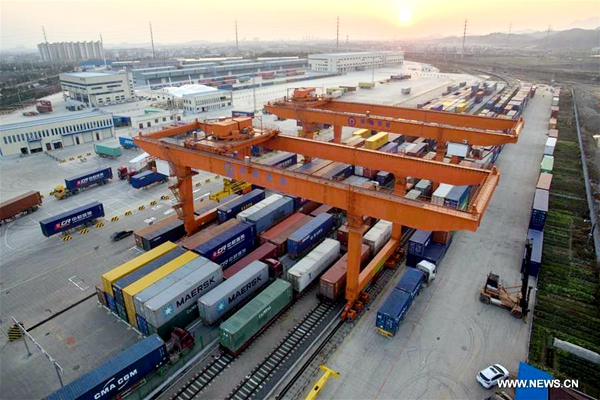The China-EU relationship: Prospects and pitfalls
- By Tim Collard
 0 Comment(s)
0 Comment(s) Print
Print E-mail China.org.cn, August 29, 2017
E-mail China.org.cn, August 29, 2017
|
|
|
Containers are seen at Yiwu West Railway Station in Yiwu, east China's Zhejiang Province, Dec. 28, 2016. The China-Europe container trains have become a major transportation channel of the international logistics industry, and also powerful support for the development of the Belt and Road initiative. [Xinhua] |
As the world tries to make sense of the USA's increasingly unpredictable international policies under Donald Trump's presidency, it is quite natural for China to be reviewing her options for active partnerships in the newly constituted world which now faces us.
Broadly speaking, it appears that the U.S. has moved away from the idea of multilateral structures in the Asia-Pacific region, with the decision to withdraw from the Trans-Pacific Partnership (TPP). This might have been welcomed as a positive step away from U.S. attempts to isolate China – but there is as yet no sign of a corresponding Sino-U.S. rapprochement on trade issues.
Nor does it appear to involve a closing of ranks between the U.S. and Europe: Views have continued to diverge on trade and climate change, and the whole issue of preserving an open, multilateral global trading system is no less in doubt across the Atlantic than across the Pacific. Trump appears still to be bound in the chains of his campaigning rhetoric: He still needs to be seen to be “putting America first,” not a good sign for the building of international partnerships.
So, with the U.S. proving difficult to deal with, what are the alternatives for China? The Belt and Road Initiative (BRI) is a very wide-ranging project to lay the foundations for increased global trade in the long term; but who are the most obvious partners in the short term? The East Asian region is racked by dissensions of all kinds; Russia and Central Asia are important partners in the security field and for gas supplies, but trade volumes there remain at a low level. So what about Europe?
A deepening partnership between China and the EU makes sense on many levels. Many of the Belt and Road projects have European countries as their ultimate destinations.
The EU, as such, is in no sense a geopolitical or military competitor of China. Until now Europe has been perfectly happy to go along with Chinese-led global development projects such as the AIIB, despite the geopolitical concerns voiced by the U.S. The EU and China constitute a quarter of the world's population and a third of its GDP.
And, on global governance issues like trade, development aid and climate change, there is much more common ground than there is with the current U.S. administration. A move towards a bilateral EU-China framework could bring great benefits to China, in terms of better market access to what is already China's largest trading partner, and could also pave the way for European recognition of China's market economy status, which would probably be a step towards ultimate U.S. recognition.
But, it can be argued, China and the EU have already established a comprehensive strategic partnership, in 2003. However, it is difficult to point out any specific major advances made under that partnership; if a new strategic axis is to become a reality, work will have to be stepped up. It was no doubt with what intention Premier Li Keqiang visited Brussels in June. However, progress was limited by continuing disagreements on the perennial problem of steel exports, as well as by the EU's refusal to recognize China's market economy status. That would be quite normal in itself; it is rare to reach agreement on complex problems during one visit. But the failure to agree on a joint communiqué was rather disturbing for observers of the bilateral process.
The problem here is that it is not really a bilateral process; while the EU claims to speak with one voice, this claim does not really stand up to scrutiny. The 28 nations – soon to be 27 – still see one another as competitors rather than as partners. More than once Chinese dialogue partner has been surprised by the difficulty of getting their European counterparts to agree among themselves.
Furthermore, the lack of unity at the heart of the EU was demonstrated spectacularly last year by the British decision to leave the union, which was not just a question of one member state defying the rest. The handling of the Greek economic crisis and the sometimes overbearing roles played by France and Germany, have also given rise to unresolved internal tensions.
But it is the British issue which shows up the most serious difficulties. Britain was always in the lead on the free trade agenda within the EU, and will continue that policy outside it. It was Britain who led the way by being the first European country to sign up to the AIIB, with the other Europeans following. The remaining EU members will do their best to exclude Britain from future benefits; it might be a good idea for China to develop strong relations with the U.K. to balance out these efforts.
Tim Collard is a columnist with China.org.cn. For more information please visit:
http://www.china.org.cn/opinion/timcollard.htm
Opinion articles reflect the views of their authors, not necessarily those of China.org.cn.







Go to Forum >>0 Comment(s)